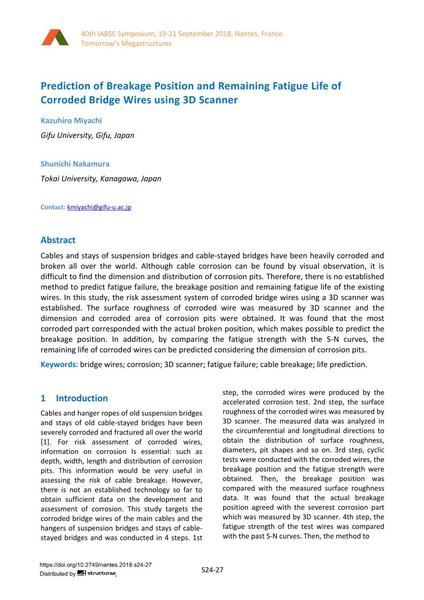Prediction of Breakage Position and Remaining Fatigue Life of Corroded Bridge Wires using 3D Scanner

|
|
|||||||||||
Bibliografische Angaben
| Autor(en): |
Kazuhiro Miyachi
Shunichi Nakamura (Tokai University, Kanagawa, Japan) |
||||
|---|---|---|---|---|---|
| Medium: | Tagungsbeitrag | ||||
| Sprache(n): | Englisch | ||||
| Tagung: | IABSE Symposium: Tomorrow’s Megastructures, Nantes, France, 19-21 September 2018 | ||||
| Veröffentlicht in: | IABSE Symposium Nantes 2018 | ||||
|
|||||
| Seite(n): | S24-27 | ||||
| Anzahl der Seiten (im PDF): | 8 | ||||
| DOI: | 10.2749/nantes.2018.s24-27 | ||||
| Abstrakt: |
Cables and stays of suspension bridges and cable-stayed bridges have been heavily corroded and broken all over the world. Although cable corrosion can be found by visual observation, it is difficult to find the dimension and distribution of corrosion pits. Therefore, there is no established method to predict fatigue failure, the breakage position and remaining fatigue life of the existing wires. In this study, the risk assessment system of corroded bridge wires using a 3D scanner was established. The surface roughness of corroded wire was measured by 3D scanner and the dimension and corroded area of corrosion pits were obtained. It was found that the most corroded part corresponded with the actual broken position, which makes possible to predict the breakage position. In addition, by comparing the fatigue strength with the S-N curves, the remaining life of corroded wires can be predicted considering the dimension of corrosion pits. |
||||
| Stichwörter: |
Korrosion 3D-Scanner
|
||||
